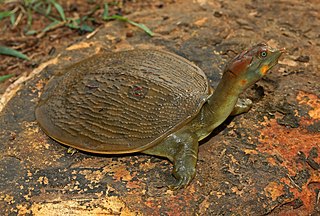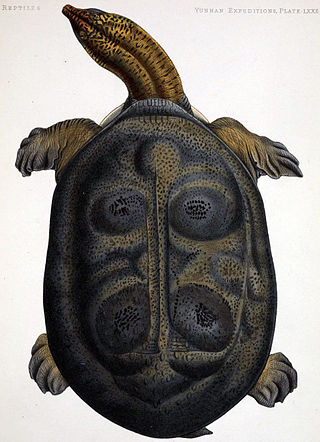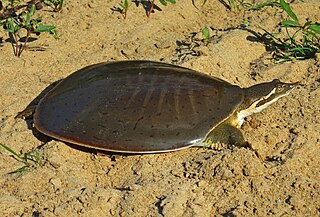
The Indian narrow-headed softshell turtle, also known as the small-headed softshell turtle or the Indo-Gangetic softshell turtle, is an endangered species of softshell turtle native to waterways and rivers of the Indian subcontinent. It is very large, feeding on fish, frogs, worms, crustaceans and molluscs, and even the occasional swimming small rodent or other mammal. C. indica, like other softshell turtles, uses it flexible shell to dig itself deep into sandy lake and river bottoms; here, it patiently waits for potential prey to swim by. They will also ambush and chase their prey, depending on availability, the time of year, and size of the prey. In the past it was included as a subspecies of Chitra chitra, a species restricted to Southeast Asia using current taxonomy.

The Asian giant softshell turtle, also known commonly as Cantor's giant softshell turtle and the frog-faced softshell turtle, is a species of freshwater turtle in the family Trionychidae. The species is native to Southeast Asia. The species is critically endangered and in the 20th century has disappeared from much of its former range.

Leith's softshell turtle is a species of turtle in the family Trionychidae. The species is found in peninsular Indian rivers including the Thungabhadra, Ghataprabha, Bhavani, Godavari, Kaveri and Moyar Rivers. The type locality is Pune in India.

The wattle-necked softshell turtle, also commonly known as Steindachner's soft-shelled turtle, is an endangered Asian species of softshell turtle in the family Trionychidae. The species is the only member of the genus Palea.

Pelochelys is a genus of very large softshell turtles in the family Trionychidae. They are found from peninsular India northeast to southern China, and south to Southeast Asia and New Guinea.

The Chinese softshell turtle is a species of softshell turtle that is native to China and Taiwan, with records of escapees—some of which have established introduced populations—in a wide range of other Asian countries, as well as Spain, Brazil and Hawaii.

Apalone is a genus of turtles in the family Trionychidae. The three species of Apalone are native to freshwater habitats in North America; they are the only living softshell turtles from the Americas.

The spiny softshell turtle is a species of softshell turtle, one of the largest freshwater turtle species in North America. Both the common name, spiny softshell, and the specific name, spinifera (spine-bearing), refer to the spiny, cone-like projections on the leading edge of the carapace, which are not scutes (scales).

The northern spiny softshell turtle is a subspecies of soft-shelled turtle in the family Trionychidae. The subspecies is native to the United States and can be found from Montana at the western edge of its range to Vermont and Quebec on the eastern edge. Introduced populations have also been found in Massachusetts, New Jersey, Arizona, and Virginia.

The Gulf Coast spiny softshell turtle, a subspecies in the Trionychidae family of softshell turtles, is endemic to the south-eastern United States.

The Cuatro Ciénegas softshell, also called the black spiny softshell, is a subspecies of the spiny softshell turtle in the family Trionychidae. It is found only in the Cuatro Ciénegas Basin in the Mexican state of Coahuila and it is considered critically endangered by the IUCN. The subspecies, along with its parent species, was formerly classified in the genus Trionyx.

Cyclanorbis is a genus of softshell turtles in the family Trionychidae. The genus is endemic to Africa.

The Burmese peacock softshell turtle is a species of softshell turtle in the Trionychidae family. It is one of five species in the genus Nilssonia.

Nilssonia is a genus of softshell turtles from rivers, streams, ponds, and lakes in South Asia and Burma. In many treatments, it is monotypic, with the single species Burmese peacock softshell. However, the supposed other genus of peacock softshells, Aspideretes, is more closely related to N. formosa than had been believed. They differ only in the neural plates between the first pleural scale pair of the bony carapace, which are fused into one in N. formosa and unfused in the others.

The red side-necked turtle, red turtle, red-footed sideneck turtle, William's toadhead turtle, or red-footed Amazon side-necked turtle is a monotypic species of turtle in the family Chelidae. It is found in Colombia and possibly Peru and Brazil. This species is dimorphic in size meaning the sexes show different characteristics. One study found that the largest female out of a group of 24 was 256 mm in carapace length. Out of that same group, the largest male was only 199 mm in carapace length. A study focused on determining how these turtles acquire their sex discovered that it is not environmentally determined rather, it is a genetic sex determination.

The smooth softshell turtle is a species of softshell turtle of the family Trionychidae. This freshwater turtle is endemic to the United States where it inhabits the Mississippi River system and other river basins emptying into the Gulf of Mexico.

Aubry's flapshell turtle is a species of softshell turtle in the family Trionychidae. The species is endemic to Central Africa.
The Burmese narrow-headed softshell turtle, also known commonly as the Myanmar narrow-headed softshell turtle and Van Dijk's chitra, is a species of turtle in the family Trionychidae. The species is endemic to Southeast Asia.
The Hunan softshell turtle is a species of turtle in the family Trionychidae, the softshells. It is endemic to China, where it occurs in Hunan, Guangdong, Guangxi, and Jiangxi provinces. It is found in Taoyuan, Pingjiang, Rucheng, Lingling, and Shaoyang counties of Hunan province.

Pelodiscus maackii, commonly known as the Amur softshell turtle or the northern Chinese softshell turtle, is a species of turtle in the family Trionychidae. The species is found in the Russian Far East, northeastern China, Korea, and Japan. It is possible that the Japanese populations are the result of ancient introductions by humans. This aquatic species may attain a straight carapace length of 32.5 cm (1.1 ft).


















